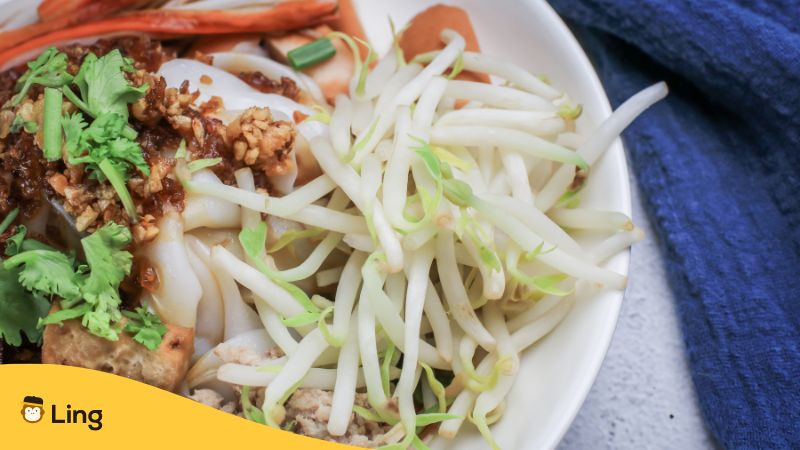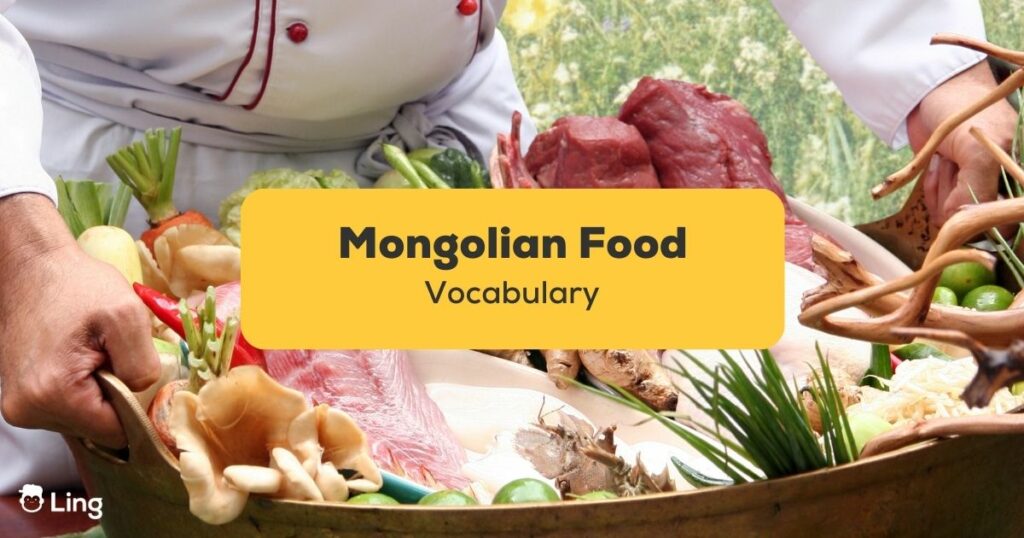Mongolian cuisine is an enigmatic and captivating facet of Mongolian culture, steeped in tradition and imbued with the flavors of the rugged, unforgiving terrain of Mongolia. The cuisine is an ode to the nomadic way of life, simple yet hearty, and designed to nourish the body and soul.
Perhaps one of the most intriguing aspects of Mongolian cuisine is its rich vocabulary. Understanding the unique names of ingredients and dishes is essential to fully appreciate the culinary artistry of this cuisine.
Mongolian Food Vocabulary
Mongolian cuisine is centered around the use of meat, with lamb, beef, and horse meat being the primary proteins. The dishes are as diverse as they are delicious, from the mouth-watering khorkhog cooked in a hot stone pot to the savory buuz, filled with succulent meat and vegetables. To fully savor these dishes, one must delve into the intricate world of Mongolian meat vocabulary, including the different cuts of boiled meat and cooking techniques employed.
But it’s not just meat that makes Mongolian cuisine so remarkable. Dairy products also play a crucial role in the cuisine, with Mongolians having produced them for centuries. Airag, a fermented mare’s milk, is a staple drink, while aaruul, made from cow’s milk, is a popular snack. And who can forget the tangy, sour, creamy tsagaan idee, a type of yogurt that is as refreshing as it is nutritious?
To experience the full depth and breadth of Mongolian cuisine, one must venture beyond the mere flavors and textures of the dishes and into the intricate vocabulary that underpins them. Each dish has its unique terminology, and understanding it adds a layer of appreciation that elevates the culinary experience to a whole new level.
Mongolian Traditional Meat Dishes
Mongolian cuisine is famous for its meat dishes, which are usually prepared using lamb, beef, or goat meat. One of the most popular meat dishes is khorkhog, where the meat is cooked in a cast-iron pot with hot stones, vegetables, and seasonings. Another favorite dish is buuz, a type of steamed dumpling filled with minced meat and spices. Boodog, where marmot meat is roasted in its skin over an open flame, is also a popular dish.
Some essential vocabulary related to meat dishes eaten in Mongolian cuisine includes:
- Khorkhog: a Mongolian dish of mutton or lamb, cooked with hot stones in a metal container.
- Buuz: steamed dumplings filled with minced meat, onion, and spices.
- Boodog: a roasted marmot dish, where the meat is cooked in its skin over hot coals.
- Huushuur: deep-fried dumplings filled with minced meat and onions.
- Khuushuur: deep-fried pastries filled with minced meat, onions, and sometimes cabbage.
Dairy Products
Dairy products are an essential component of Mongolian cuisine and play a vital role in the nomadic lifestyle. Some popular dairy products include airag (fermented mare’s milk), aaruul (dried curds), and tarag (yogurt). Airag is a traditional Mongolian beverage made by fermenting mare’s milk, while aaruul is a type of dried curd made from cow milk. Tarag, a type of yogurt, is often served as a side dish with main courses.
Some essential vocabulary related to dairy products in Mongolian cuisine includes:
- Airag: a traditional Mongolian beverage made from fermented mare’s milk.
- Aaruul: dried curd made from milk.
- Tarag: a type of yogurt, often served as a side dish with main courses.
- Byaslag: a type of cheese made from cow’s milk.

Traditional Grain-Based Dishes In Mongolia
Mongolian cuisine boasts a stunning variety of grain-based dishes that are bound to tantalize your taste buds! In particular, Mongolian cuisine is famous for its skillful use of wheat and rice to create delectable dishes that are both hearty and flavorful.
One of the most beloved dishes in Mongolia is Tsuivan, a mouth-watering creation that combines the perfect blend of stir-fried noodles, succulent meat, and an array of fresh vegetables. The aroma of this dish alone is enough to make your mouth water, and the flavors are sure to transport you to the vast, rolling steppes of Mongolia.
Another popular dish is Huushuur, a savory deep-fried pastry that is filled with tender minced meat, tangy onions, and perhaps even a hint of crisp cabbage. The crispiness of the pastry, coupled with the sumptuous flavors of fatty meat in the filling, makes for a delectable culinary experience that is simply unmatched.
And let’s not forget about Boortsog, a tantalizing type of fried dough that is a staple in Mongolian cuisine. Whether you’re looking for a healthy, quick snack to keep you going throughout the day or a sweet dessert to round off your meal, Boortsog has got you covered. Crispy on the outside and fluffy on the inside, this fried delight is sure to satisfy any craving.
Some essential vocabulary related to grain-based dishes in Mongolian cuisine includes:
- Tsuivan: stir-fried noodles with meat and vegetables.
- Khuushuur: deep-fried pastries filled with minced meat, onions, and sometimes cabbage.
- Boortsog: fried dough, often served as a snack or dessert.
Traditional Mongolian Beverages
At the heart of its cuisine lies an array of traditional beverages, crafted with the utmost care and skill.
One such drink is airag, a fermented mare’s milk that packs a punch. This potent beverage is a popular choice for special occasions, where it is enjoyed with friends and family. Its distinct flavor and aroma are a testament to the country’s nomadic heritage and speak to the resourcefulness of its people.
If you’re in the mood for something milder but equally delightful, look no further than suutei tsai. This comforting milk tea, made with a hint of salt, is a staple beverage in Mongolian cuisine. It warms the soul on cold winter nights and refreshes on hot summer days, making it a year-round favorite.
And for those looking for a more substantial beverage, guriltai shul is just the thing. This hearty soup, chock-full of meat, vegetables, and rice, is a popular choice for those in need of sustenance. Its rich, savory flavor is perfect for warming up after a warm day spent in the great outdoors.
So, if you ever find yourself in Mongolia, make sure to try out these traditional beverages. They are a true testament to the country’s unique culinary heritage and are sure to leave a lasting impression on your taste buds.
Some essential vocabulary related to beverages in Mongolian cuisine includes:
- Airag: a traditional Mongolian beverage made from fermented mare’s milk.
- Suutei tsai: a type of milk tea made with salt.
- Guriltai shul: a type of soup made with meat, vegetables, and rice.
- Tsai: tea.
Spices And Seasonings In Mongolia
With its rich and vibrant history, Mongolian cuisine boasts an array of exquisite spices and seasonings that elevate meat dishes to new heights of deliciousness.
From the pungent aroma of garlic to the warming heat of ginger, every spice is carefully chosen to create a symphony of flavors and tastes that dance across your taste buds. The deep, earthy notes of cumin mingle with the sharp tang of black pepper to create a taste that is both bold and refined.
But it’s not just the spices that make Mongolian cuisine so special. Salt, the unsung hero of the culinary world, is a crucial ingredient in many Mongolian dishes, especially those based on dairy, like suutei tsai. It adds depth and complexity to the flavors, bringing out the natural sweetness of the milk and cream.
In the hands of skilled Mongolian chefs, these spices, herbs, and seasonings become a magic wand, transforming simple ingredients into culinary masterpieces. Mongolian cuisine is a celebration of flavor, a symphony of spices that tantalize the senses and leave you craving for more. So come, let’s savor the rich and complex flavors of Mongolian cuisine, and discover a world of taste that will leave you spellbound.
Some essential vocabulary related to spices and seasonings in Mongolian cuisine includes:
- Garlic: tus
- Ginger: zansho
- Cumin: zira
- Black pepper: shultei tsagaan idee
- Salt: dal

Wrapping Up
From the mouth-watering aroma of sizzling meat skewers to the delicate flavors of handmade dumplings, each Mongolian dish is a testament to the country’s unique traditions and rich heritage.
To truly savor and appreciate the depth and complexity of Mongolian cuisine, one must first grasp its vocabulary. Understanding the language of food is essential for unlocking the secrets behind each recipe and ingredient, enabling one to immerse themselves fully in the cultural experience.
By delving into the nuances of Mongolian food vocabulary, one can develop a profound appreciation for the diverse range of flavors, textures, and spices that are intrinsic to this cuisine. Moreover, it facilitates effective communication with friendly locals, who are always eager to share their culinary knowledge and recommendations.
So go ahead, download Ling today from the Play Store or App Store, and get ready to embark on the adventure of a lifetime!
If you’re interested in Mongolian culture and language, you can also check out our articles on Mongolian sentence structure and Mongolian shopping vocabulary.


































































